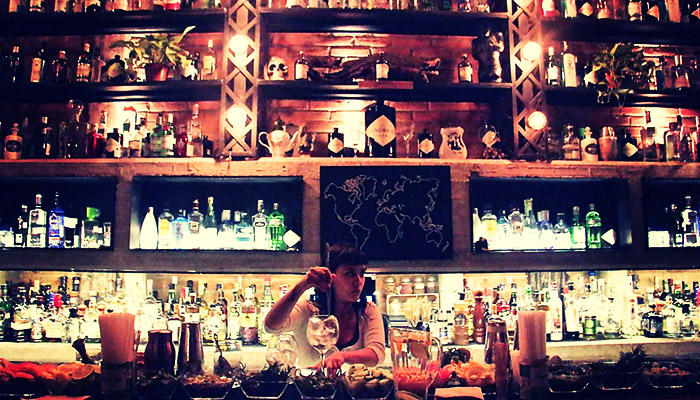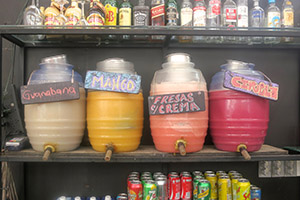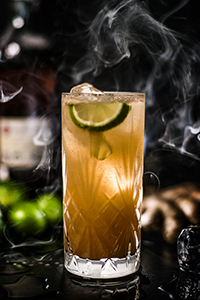
It’s a good time to raise a glass in Mexico City. Not only is the city is starting to see a rise in craft cocktail bars, but its blossoming craft beer movement has microbreweries and specialty beer stores emerging all over. And though regionally produced, agave-based spirits have always played an important role in Mexican culture, mezcal has become deeply ingrained in the city’s food and drink scene. Neighborhood mezcalerias continue to multiply and the spirit is ubiquitous in restaurants, both casual and upscale. Pulque, the thick, fermented agave sap with pre-Hispanic roots, nearly disappeared from popular existence until it was revived by bartenders around town who decided to serve it straight and in curados (pulque drinks) mixed with various juices and infusions. Indeed, the Federal District has something for everyone’s taste. Here’s a short list of places to get you started.
Licorería Limantour
When Licorería Limantour opened its doors in Roma in 2011, it changed the face of Mexico’s cocktail scene, which was just barely starting to take off. It gained immediate success for its sophisticated cocktail creations that made use of local herbs, fresh spices, housemade syrups and shrubs and artisanal spirits. Two years later, it opened a location in upscale Polanco. The patio is great for people-watching while sipping and snacking on items like tuna tostadas and prosciutto empanadas. While the bartenders have perfected the classics, the spot also features signature concoctions such as the margarita al pastor, a play on the flavors found in the city’s famous al pastor tacos — pineapple, muddled cilantro and serrano. Limantour also has several well-balanced mezcal cocktails, such as the Machete (mezcal, mandarin liqueur, agave nectar and spearmint).
Pulqueria Los Insurgentes
The aforementioned pulque has ancient Mexican roots, but until recent years, it was almost exclusively consumed in a handful of male-dominated, working-class pulquerias. Perhaps due in part to a renewed interest in local, artisanal products, Mexico’s younger crowd is popularizing pulque again. The tangy drink can be found in hipster hangouts around the city, but Pulqueria Los Insurgentes in Roma Norte was one of the first to bring it back. Order it natural (or plain), which tastes very similar to a yogurt drink, or mix it with juices to create flavors like peanut, tomato, mango, raspberry, celery and oatmeal. Los Insurgentes also experiments with various pulque cocktails, such as a the Split, which gets a smoky kick from mezcal, some sweetness from banana liqueur and additional creaminess from condensed milk before it is whipped into a dessert-like frozen drink. Enjoy the libations from the rooftop patio, where you might just find yourself hanging out long enough for lower levels to erupt into a full-fledged dance party.
Bósforo
These days, Mexico City has handfuls of little mezcalerias from which to choose. La Bòtica, La Clandestina and the upscale Corazón de Maguey are three that immediately come to mind. But one of the city’s best mezcalerias is tucked behind a curtained door, between a hotel and a 7-Eleven in Centro Histórico. Bósforo exists in a tall, skinny space where low-hanging pendant lights cast a greenish glow, flickering candles add ambience and owner Arturo’s impeccable soundtrack curates the evening’s vibe. The spot carries an impressive collection of small-production mezcal from the seven Mexican states where it is produced. Knowledgeable bartenders help guide your selection by asking your favorite flavor profiles — do you like yours smokier? Grassier? Stronger? Lighter? Each copita is served with orange slices sprinkled with traditional sal de gusano (worm salt), which acts as a savory-sweet-pungent accompaniment. Tiny bowls of cacahuates con ajo (peanuts with whole dried garlic cloves) are the snack missing from American bars everywhere. And if you work up a bit more of an appetite, try the signature quesadilla, a blue corn tortilla lined with hoja santa (an aromatic leaf), then layered with Oaxacan cheese, sprinkled with chapulines (grasshoppers) and served with freshly ground salsa, still in the molcajete (the traditional version of mortar and pestle).
Jules Basement
In true speakeasy form, Jules Basement is located inside a Mexican restaurant and behind a faux refrigerator door. Call for reservations ahead of time and check in with the inconspicuous doorman, who will then grant access down the dark stairs into the bass-thumping abyss. Named after the street where it is located (Julio Verne in Polanco), Jules Basement exudes a space-age interior design that makes the small space seem bigger; the geometric shapes and contrasting textures of the bar, stools, tables and ceiling all interact with one another while playful lighting casts vertical floor-to-ceiling shadows. Lead bartender Carlos Soto moves at the speed of light while shaking and stirring creations — the perfectly tart Flor de Sangre (tequila, hibiscus, lemon, agave and hibiscus foam) and the smoky-spiced Mezcal Negroni (mezcal, cinnamon- and chile-infused Campari, Punt e Mes vermouth, orange and coffee bitters) are two examples — from his cocktail program.
Beer Bank
Mexico City’s craft beer scene, while still in its infancy, is growing exponentially every few months. Beer Bank happens to be one of its most impressive entries. Coolers in the center of the establishment hold bottles of Tierra Firme American pale ale, Cerveza Minerva imperial tequila ale, Cucapá Obscura brown ale and Baja Razz, a raspberry ale made by Baja Brewing Co. Despite its small size, the Beer Bank manages to pack a lot within its walls; the place houses more than 200 types of well-curated beer. And while purchases are available for carryout, it’s not uncommon for patrons to break into karaoke and push back tables to create a dance floor.
Gin Gin
When Gin Gin opened in La Roma last summer, it was intended to be a speakeasy where reservations were only accepted via Facebook. Of course, when you pull back the curtain at the entrance and step into the expansive bar, you’ll find it hard to imagine such a stunning space being kept a secret for very long. Shelves of bottles stretch up to meet the lofty ceiling, while lush greenery seems to grow straight out of an industrial brick wall. A mysterious barrier of skulls serves as the conversation piece in a darker room. As indicated by the name, Gin Gin specializes in a certain spirit that is found both in its pure form and infused in creations like the Acapulco Golden (maté-spiked Bombay, Kalani licor de coco, pineapple and coconut water) and the eponymous Gin Gin (ginkgo biloba-sprinkled Bombay, Canton Domaine liqueur, ginseng extract, cardamom and tonic). The bartenders plug fresh herbs, botanical and fruits from containers using long chef’s twisters, which also stir and build each drink. You’ll discover a bar menu, where even some of the dishes from the kitchen incorporate gin, such as the pulpo a la Hendrick’s (octopus marinated in paprika and Hendrick’s vinaigrette) and aguachile Bombay (fish soaked in a Bombay chile sauce).



